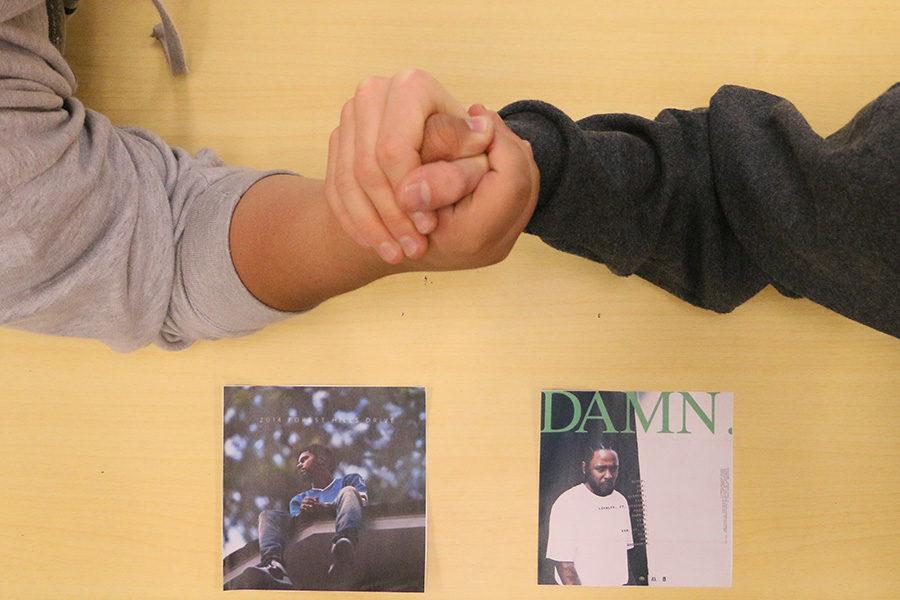Comparing rap proves impossible without categories
Students quarrel over their favorite albums. On the left is 2014, Forest Hills Drive by J. Cole and on the right is DAMN. by Kendrick Lamar.
Travis Scott is the single best rapper of our generation. So is Kendrick Lamar and so is A$AP Ferg, Lil Pump, etc. No matter how strenuously you argue, you will (unfortunately) never be able to say that Lil Pump is better than Kendrick Lamar as an absolute statement. Rap and all art is intensely subjective to each person. Everyone is right to themselves and wrong to all others in their own musical choice.
When it comes to the epitome of modern American culture, rap takes the podium as representative. The categories and subcategories of rap have expanded dramatically from day one R&B into a complex webbing of multicategorical artistic movements and new trends on the daily. However, we can still lump most rappers into general categories of trends and then analyze the rappers in comparison to their peers. Below is a list of five very general rap categories and the top dogs of each.
Storyteller: The storyteller rapper is able to cleverly lace personal experience into quick tempos and convey a specific story of struggle or successes. This line of rap can appeal to most but tends to be in the playlist of more hipsters and throwbackers. The pinnacle performance of this category is The Notorious B.I.G. who uses his platform to discuss his upbringing in crime, especially drug dealing, with tracks such as his “Ten Crack Commandments.”
Lyricist: The lyricist is able to portray a societal issue and form critiques all within the parameters of their beats. There is often overlap between lyrical and storytelling rap due to the often difficult upbringings of rappers. This brand of rap is mostly found in the playlists of intellectual thinkers. The shining example of success in this category is Joey Bada$$ who ruthlessly criticizes the criminal justice system in America in songs such as his “AMERIKKKAN IDOL.”
Driller: The driller, who is categorized under drill rap, is able to hype up an audience with as few words as necessary. Drill rap originated out of the southside of Chicago and gained a mainstream audience through features with prominent rappers like Drake and Kanye West. This brand of rap is usually found in a gym junkies or party hype playlist. The most common example of a drill rapper is Chief Keef who rhymes about drug habits and violence in his hometown of Chicago on rudimentary bass boosted beats. Chief Keef has starred in songs such as “Love Sosa” and “3Hunna.”
Mumbler: The mumbler, which has become the most mainstream in the contemporary rap game, is able to flow and pour their lyrics onto well produced beats. Due to its cliche and lackluster lyrics, this genre of rap tends to have a heavy reliance on producers of beats such as Metro Boomin. This class of rap is commonly found in the playlists of… well everyone, no matter how much they criticize it. The dominating force in this category is the Atlanta trio Migos who tell their tales of success on songs such as Bad and Boujee and most recently, Motorsport.
Multicategorical: The multicategorical rapper is the misfit. They combine aspects of every aforementioned category and blend it into a creative combination. You just can’t put them into one category. This type of rap is usually more lowkey due to its nonspecific appeal, but there are some cases of mainstream multicategorical rappers. This breed is usually not found on the mainstream playlist, but when it is, it can be found anywhere due to its general appeal. The best example of this rap is Travis Scott, a Houston rapper that projects stories of addiction, heartbreak and the shortcomings of monetary success. This universal appeal can be found on songs such as “3500,” “90210,” “Way Back” and “sdp interlude.”
As mentioned earlier, there is no real way to judge artists and definitively say one is better than another, but if you build a basis for comparing artists, you can definitely find your own personal dearest and relatable rapper. Be warned, not everyone will agree with your tastes and that’s alright.
Your donation will support the student journalists of Harrisonburg High School. Your contribution will allow us to purchase equipment and cover our annual website hosting costs.





